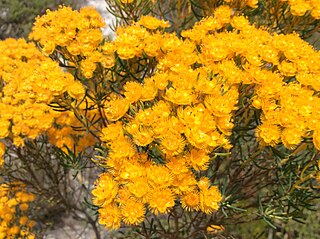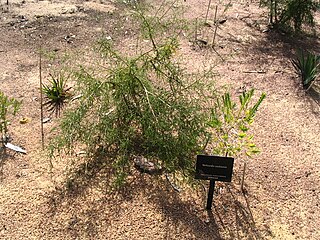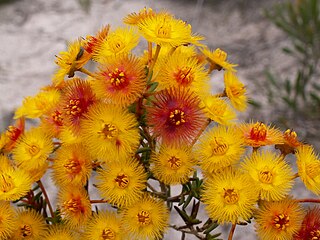
Verticordia insignis is a species of flowering plant in the myrtle family, Myrtaceae and is endemic to the south-west of Western Australia. It is an open, irregularly-branched shrub with small leaves and heads of relatively large pink, or white and pink flowers on the ends of the branches in spring.

Verticordia nitens, commonly known as Christmas Morrison and other names, is a flowering plant in the myrtle family, Myrtaceae and is endemic to the south-west of Western Australia. The Noongar peoples know the plant as kotyeningara. It is an upright shrub with glistening and perfumed flower heads that appear between October and February. The small compact and erect flowers have been noted for their beauty. Although it occurs in areas near Perth, Morrison featherflower is not classed as rare or endangered because it still occurs in large populations, although its numbers have undoubtedly been reduced as a result of urban development.

Verticordia citrella is a flowering plant in the myrtle family, Myrtaceae and is endemic to the south-west of Western Australia. It is a small, densely-branched shrub with cylinder shaped stem leaves that differ from those near the flowers, and small yellow flowers in groups near the ends of the branches.
Verticordia aereiflora is a flowering plant in the myrtle family, Myrtaceae and is endemic to the south-west of Western Australia. It is a thin but bushy shrub with small leaves and greenish-yellow flowers with red spots and red fringes on the sepals.
Verticordia amphigia commonly known as pixie ears is a flowering plant in the myrtle family, Myrtaceae and is endemic to the south-west of Western Australia. It is usually an open, much-branched shrub with narrow leaves and yellow flowers which sometimes produce a "sea" of colour in the wild. The flowers are surrounded by boat-shaped bracteoles which give the plant both its common and scientific names.
Verticordia aurea, commonly known as buttercups is a flowering plant in the myrtle family, Myrtaceae and is endemic to the south-west of Western Australia. It is a slender, sometimes bushy shrub with a single stem at the base, cylindrical leaves and heads of scented, golden-yellow flowers in spring.

Verticordia subulata is a flowering plant in the myrtle family, Myrtaceae and is endemic to the south-west of Western Australia. It is a woody shrub with pointed, linear leaves and in spring, heads of yellow flowers which turn red as they age.

Verticordia decussata is a flowering plant in the myrtle family, Myrtaceae and is endemic to an area in the north of the Northern Territory. It is an open shrub with a distinctive leaves and leaf arrangement and small spikes of cream to white flowers on the ends of the branches.

Verticordia galeata is a flowering plant in the myrtle family, Myrtaceae and is endemic to the south-west of Western Australia. It is a woody shrub with thin, pointed cylinder-shaped leaves and heads of bright yellow flowers on the ends of the branches in spring.

Verticordia cooloomia, commonly known as Cooloomia verticordia, is a flowering plant in the myrtle family, Myrtaceae and is endemic to the south-west of Western Australia. It is an open, spreading shrub with large heads of sharply scented yellow flowers and is only known from areas in and near to the Cooloomia Nature Reserve, near the Murchison River.

Verticordia chrysanthella, commonly known as little chrysantha, is a flowering plant in the myrtle family, Myrtaceae and is endemic to the south-west of Western Australia. It is a shrub with cylinder-shaped leaves and small groups of lemon-yellow to gold-coloured flowers which fade to orange, red or brown.
Verticordia coronata is a flowering plant in the myrtle family, Myrtaceae and is endemic to the south-west of Western Australia. It is a small shrub with leaves whose shape depends on their position on the plant, and groups of yellow flowers near the ends of the branches.

Verticordia endlicheriana is a flowering plant in the myrtle family, Myrtaceae and is endemic to the south-west of Western Australia. It is a shrub with narrow leaves and yellow flowers which in some varieties age to red. It is a variable species and in his 1991 paper, Alex George formally described five varieties.
Verticordia endlicheriana var. compacta is a flowering plant in the myrtle family, Myrtaceae and is endemic to the south-west of Western Australia. It is a small, usually compact shrub with sweetly-perfumed, golden-yellow flowers which fade through reddish to almost black as they age.

Verticordia grandiflora, commonly known as claw featherflower, clawed featherflower or horned featherflower, is a flowering plant in the myrtle family Myrtaceae, and is endemic to the south-west of Western Australia. It is a small, rigid shrub with many short side-branches, mostly linear leaves and heads of yellow flowers which soon age to reddish but which are among the largest in the genus. It is similar in appearance to several other species of verticordias with which it is often confused.
Verticordia helmsii is a flowering plant in the myrtle family, Myrtaceae and is endemic to the south-west of Western Australia. It is a shrub with most of its leaves clustered on short side branches and with small groups of scented creamish-white flowers in small groups along the branches.
Verticordia interioris is a flowering plant in the myrtle family, Myrtaceae and is endemic to the south-west of Western Australia. It is an openly branched shrub with small, linear leaves and rounded groups of pale to dark pink flowers in early spring.

Verticordia laciniata is a flowering plant in the myrtle family, Myrtaceae and is endemic to the south-west of Western Australia. It is an openly branched shrub with linear, slightly hairy leaves and heads of scented, bright yellow flowers which turn red then bronze-coloured as they age.
Verticordia luteola is a flowering plant in the myrtle family Myrtaceae, and is endemic to the south-west of Western Australia. It is a more or less openly branched shrub with crowded leaves on its side branches and spikes of pale yellow or bright pink flowers which turn cream to brownish as they age. This verticordia is a summer-flowering species.

Verticordia nobilis, commonly known as northern grandiflora, is a flowering plant in the myrtle family, Myrtaceae and is endemic to the south-west of Western Australia. It is an openly branched shrub with linear leaves and groups of scented, yellow flowers which turn deep red as they age.











